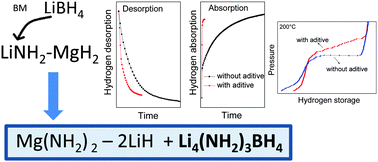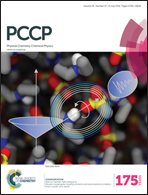Effective participation of Li4(NH2)3BH4 in the dehydrogenation pathway of the Mg(NH2)2–2LiH composite†
Abstract
Lithium fast-ion conductors have shown positive effects on the hydrogen storage properties of the Li–Mg–N–H system. In the present work, Li4(NH2)3BH4 doped Mg(NH2)2–2LiH was formed by milling the 2LiNH2–MgH2–0.2LiBH4 composite and posterior annealing under hydrogen pressure to reduce the kinetic barrier of the Li–Mg–N–H system. The effect of repetitive dehydrogenation/rehydrogenation cycles on the kinetic and thermodynamic performance was evaluated. The dehydrogenation rate in the doped composite was twice that in the un-doped sample at 200 °C, while hydrogenation was 20 times faster. The activation energy decreases by 9% due to the presence of Li4(NH2)3BH4 compared to the un-doped composite, evidencing its catalytic role. The presence of Li4(NH2)3BH4 in the composite stabilized the hydrogen storage capacity after successive sorption cycles. Thermodynamic studies revealed a variation in the pressure composition isotherm curves between the first dehydrogenation cycle and the subsequent. The Li4(NH2)3BH4 doped composite showed a sloped plateau region at higher equilibrium pressure in regard to the flat plateau of the un-doped composite. Detailed structural investigations revealed the effective influence of Li4(NH2)3BH4 in different reactions: the irreversible dehydrogenation in the presence of MgH2 and the reversible hydrogen release when it reacts with Li2Mg2(NH)3. The role of Li4(NH2)3BH4 in improving the dehydrogenation kinetics is associated with the weakening of the N–H bond and the mobile small ion mass transfer enhancement.


 Please wait while we load your content...
Please wait while we load your content...